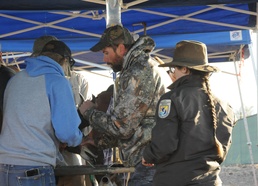
At one time the Sonoran pronghorn population was on the brink of extinction. The dry summer of 2002 wiped out 75% of the pronghorn population. With no measurable rainfall for 13 months the –populations could not survive.
“The summer rainfall is critical on fawns trying to survive,” explains Daniel Steward, Yuma Proving Ground (YPG) wildlife biologist.
Since that time, the efforts to revive the pronghorn population on the Kofa National Wildlife Refuge (NWR) and Cabeza Prieta NWR are basically bringing them back to their historic range.
After the summer of 2002, only about 25 pronghorn existed in the U.S. Today, about 280 pronghorn live on the Cabeza Prieta NWR and another 130 in the Kofa area. This brings the numbers very close to the goal of 150 pronghorn at Kofa.
“We are supposed to maintain that number five to seven years and show a trend of stable and increasing populations,” explains Steward adding, “It’s not just about putting more pronghorn out there…the trick is to promote the habitat and reduce the threats. To let pronghorn survive without our intervention.”
Currently several agencies are managing semi-captive breeding pens on Kofa and Cabeza Prieta NWRs. These pens are approximately 300 acres in size and allow pronghorn to live in their natural environment with supplemental food water and predator exclusion to maximize fawn survival. The agencies then capture animals from the pen annually for release into the wild.
Every federal agency in southwest Arizona has played a part in bringing back the species yet Steward credits Arizona Game and Fish and U.S. Fish and Wildlife Service for being the technical experts and the leaders.
Members from each agency camp on the refuge to start their day early. They need to prepare the tents where veterinarians will examine the pronghorns.
Leading up to the capture, a multi-chambered pen, or boma, is constructed inside the massive breeding pens. The pronghorn are conditioned over a period of weeks to enter a boma for food and water. When the team is ready to capture the pronghorn, an observer will watch for the maximum number of pronghorn to enter the boma, then they close the door. The boma is made up of three circular pins so the pronghorn can be gently herded between chambers so only two or three pronghorn are in the capture chamber.
To capture the pronghorn, a capture crew will run in with a net to slow the animals down and the “muggers” with actually grab and subdue to the pronghorn to load them on stretchers. YPG personnel helped with the net crew, stretcher transport and mugging.
“The muggers have a special skill set because safety is paramount for both the crew and the animals,” Steward adds, “Everybody gets kicked.” Reed Rider, YPG natural resource specialist has the mugging job for the YPG crew.
At this point the stretcher team of about four people come in and transport the pronghorn to the vet tents.
Once at the examination tent veterinarians administer vitamins, antibiotics and oxygen, to the pronghorn, to reduce stress. The vets check the animal for any injuries. The targeted pronghorn that are being transported to YPG’s East Arm get a sedative so they can sleep during the trip. The pronghorn who are staying in the Kofa pen are let to run free.
During the recent gather in early January, the teams transported two bucks and seven does. They were equipped with GPS and radio frequency trackers. The hope is that they meet up with the existing heard.
Steward says, “Basically they are lost until they find one another so it’s good to have animals already on the range that know where the food and water is, that know where the safe places are.”
The ultimate the goal of this effort and also habitat improvements is to build a strong and self-sustaining pronghorn population.
“Our role as a Federal agency under the endangered species act is to promote ecosystems where endangered animals can recover and thrive.”
Taking the Sonoran Pronghorn off the endangered species list is the eventual goal.
“Once we can meet these recovery criteria then we can take a good hard look at delisting the species.”